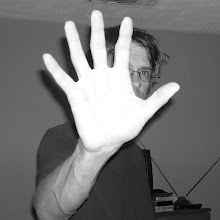 The new issue of Harper's (March, 2009) contains a fascinating essay entitled, "Raiders of the Lost R2" by Jon Mooallem. It's about the obsession of some Star Wars fans to seek out the actual shooting locations of the films and scavenge those sites for props and set pieces that may have been left behind. Some fans have gone to great lengths to locate sites in Tunisia that doubled for Tatooine, or find Mayan ruins that were used for some establishing shots on Yavin's fourth moon, or visit sites in Finse, Norway that were used for the ice planet of Hoth.
The new issue of Harper's (March, 2009) contains a fascinating essay entitled, "Raiders of the Lost R2" by Jon Mooallem. It's about the obsession of some Star Wars fans to seek out the actual shooting locations of the films and scavenge those sites for props and set pieces that may have been left behind. Some fans have gone to great lengths to locate sites in Tunisia that doubled for Tatooine, or find Mayan ruins that were used for some establishing shots on Yavin's fourth moon, or visit sites in Finse, Norway that were used for the ice planet of Hoth. The article recounts a visit Mooallem made with a trio of Star Wars fans to Imperial Sand Dunes National Monument in California where, in the inaptly named Buttercup Valley, scenes from Return of the Jedi were filmed in 1982. These scenes depicted action around the Sarlacc Pit and Jabba the Hutt's sail barge. Apparently, remnants of the barge and pit film sets—broken bits of weathered foam and painted plywood—still exist, buried under the hot California sand. Many fans hope to salvage these fragments, carry them out of the desert, and add them to their Star Wars memorabilia as prized collector's items. This is what the group with Mooallem was hoping to do.
Now, I know what it's like to be fascinated by a fictional world. There was a time when I lived and breathed Twin Peaks. I have my prized props and I've been to film sites of the pilot and Fire Walk With Me in Washington state. I understand how important it is to connect with that "other" world; how fascinated one can become with those fixed points on earth where a fictional world intersects with the real. But I wonder at the import of finding the flotsam and jetsam of long-abandoned film sites. What does finding these artifacts (which are indistinguishable from any construction site debris) really mean to a fan?
Mooellam wonders the same thing. He argues that Star Wars (and other imagined worlds) "takes on a specificity and a grit" of a real world. It is a world that demands to be defined and in so doing might require "adults [to] journey great distances to stand inside that universe and handle it for real" (p. 67). But what do you get when you stand inside that other world? What does "handling it for real" mean? To me, seeing Jabba's barge as nothing more than plywood and latex paint diminishes the whole experience. The faraway idea of Star Wars instantly becomes grounded and mundane. Hand-crafted props are one thing, junk from a movie set is something else.
Still, I can reluctantly relate to the whole endeavor. The notion that some piece of treasure (an actual blaster prop or a Gamorrean helmet) might await under the California sand is compelling. But the compulsion to find such treasure is also worrisome. How simple is it to step over the line that demarcates diversion from obsession? How easy is it to develop the "tic" in fanatic? I don't know, but it seems like something to guard against.
If you want to know more about the Buttercup Valley "excavation," check out this blog for pictures and behind-the-scenes notes (including images of the rather dull pieces the group found). Mooallen's Harper's essay is not online, however (unless you are a Harper's subscriber), so you'll probably have to obtain a copy of the magazine to read it.



Fascinating! Let's not forget logging the locations of the Twin Peaks filming sites by the dedicated Charles at intwinpeaks.com !
ReplyDeleteLoved readiing this thank you
ReplyDelete